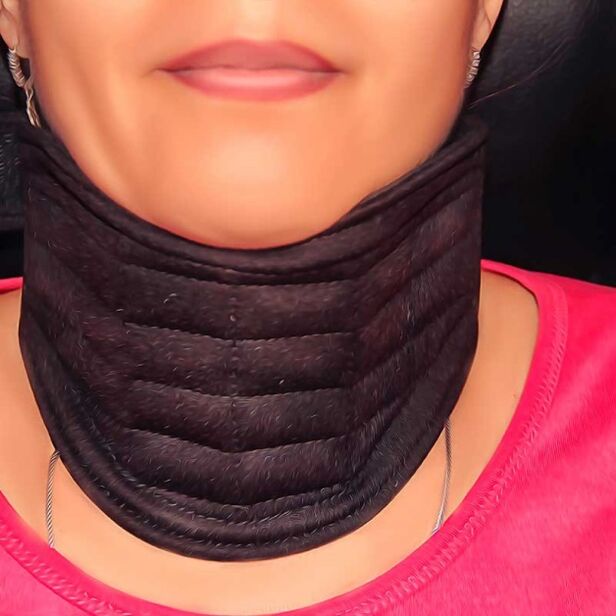Osteochondrosis of the cervical spine is asymptomatic as long as the intervertebral discs cope with their cushioning functions. As their thickness begins to decrease, instability develops. The body compensates for this with the growth of osteophytes, resulting in stiffness in the neck, and other unpleasant symptoms that significantly worsen the quality of life over time. Treatment of osteochondrosis of the cervical spine should be comprehensive.

This means that medication alone (needles, tablets, ointments) is not enough. In addition, it is important to do special therapeutic exercises, massage, hirudotherapy courses (treatment of leprosy), as well as basic exercises at home. In addition to the main treatment, the use of folk remedies is allowed.
Medications
The doctor's priority is to relieve the patient of pain. An entire drug complex is used for this purpose:
- non-steroidal anti-inflammatory;
- anesthetic and hormonal (for blockage);
- muscle relaxant;
- chondroprotectors;
- sedatives and antidepressants;
- B vitamins.
The groups of drugs listed in the complex play the role of a powerful anesthetic complex for osteochondrosis, as well as nourish the intervertebral discs and restore nerves:
- NSAIDs relieve mild to severe inflammation and pain.
- Anesthetics and hormonal agents are injected instead of pain (paravertebral or vagosympathetic) - the pain syndrome stops immediately. Then the neck brace is put on for a while so that the patient cannot move his head sharply.
- Muscle relaxants are used to relax spasmodic muscles.
- Chondroprotectors improve the nutrition of intervertebral discs. Their admission begins at the same time as NSAIDs. The use of chondroprotectors is usually long-term and complex. This means that in addition to external agents, the doctor may prescribe oral medications, as well as injections.
- Sedatives and antidepressants help the patient cope with stress, prevent depression, which in turn helps to cope with muscle tension.
- Lack of complex preparations of B vitamins B1, 6 and 12 adversely affects nerve fibers and neuronal conductivity. First, the drug is prescribed in the form of injections in a short course, then switch to supportive therapy and take pills.
Note. Most NSAIDs and chondroprotectors are available in various forms - tablets, ointments, injections, as well as rectal suppositories (NSAIDs) and patches (NSAIDs).
Therapeutic gymnastics and massage
As the pain syndrome subsides, the motor activity of the cervical spine should be gradually increased. If the patient has a blockage, the bandage is removed after about a week.

Some doctors believe that it is always necessary to act. When a patient is prescribed bed rest, it is believed that it helps to cope with the disease, but in fact the person has the opposite effect - spasmodic muscles on one side of the neck are limited if no muscle relaxant is used, on the other hand, their gradual weakening (fading andor loss of tone) is observed. As a result, returning to the rhythm of work, in a fairly short time, a patient with cervical osteochondrosis will inevitably again experience pain, limited mobility and muscle spasms. If you exercise regularly and in small doses, but on a regular basis, you can relieve pain with minimal use of painkillers.
Physiotherapists and chiropractors share the same view. Because 90% of physicians who try to relieve pain in patients with cervical osteochondrosis defend it, their techniques are based on movement, not lying in bed.
Exercises for acute pain
This is static gymnastics in which the cervical spine does not move at all. Physiotherapist recommends the following 3 exercises for headaches, tinnitus, neck pain:
- Sit in a chair, straighten your back, look straight. Put your hands on top of each other and place them under your chin. Start pressing your chin into your hands, as if you want to lower your head. At this point, the spine is not involved in any way, but the muscles of the front of the neck are tense. Press on your hands for 3-5 seconds, then lower your arms and relax. Repeat several times.
- Keep sitting straight on your back and look forward. Place the back of your right hand on your cheek. Start turning your head to the right as you resist with your hands. The head is motionless. Press for 3-5 seconds, then remove your hand and relax. Repeat several times. Repeat №2 exercise with the other hand.
- Place the brushes on top of each other at the back of your head. Imagine throwing your head back. Resist with your hands. Lie down for 3-5 seconds immediately under pressure. Then lower your arms and relax. Repeat several times.
You do not need to put pressure on your hands with all your might. This will have the opposite effect - the pain will intensify. All movements are as smooth, slow and inflexible as possible. The number of approaches is 2-3 times a day.
Note. Static exercises are similar to micro-movement techniques. As a result, the muscles relax and the pain gradually disappears.
A universal set of exercises for cervical osteochondrosis
Gymnastics can be performed independently at home, both in remission and during inflammation.
The universal complex consists of 6 exercises:
- Stand up straight, feet shoulder-width apart, chest wide. Put your hands on your shoulders. Perform symmetrical circular motions backwards (at least 10 times), then forward (10 times). The body and neck are motionless. After training, lower your arms and shake your shoulders, relax.
- Keep up the good work. Spread your arms parallel to the ground, clench your fists. Now imagine swinging dumbbells. At the same time, bend your elbows and touch your shoulders with your fists, then straighten. Repeat 10-15 times. After the exercise, shake your hands off your shoulders and relax.
- Stay in the starting position. Training is static. Close your fingers and place your palms on your forehead. Start as you would to push your head forward. Resist with your hands. Hold under pressure for 3-5 seconds, then relax. The muscles of the back of the neck work.
- Exercise No. 3 from the complex with exacerbation of cervical osteochondrosis.
- From the starting position, without moving your neck, bring your shoulders to the front, hold for 3-5 seconds, then straighten and join your shoulder blades and relax. Repeat several times.
- From the starting position: take a deep breath through your nose - raise your arms to the sides and up, lower in front of you - breathe completely through your mouth. In a sharp period, raise your arms down - parallel to the ground.
Note. For complete treatment of the cervixosteochondrosisthese exercises are not enough. However, they are suitable for relieving acute pain and restoring spinal mobility.
Micro-movements
A chiropractor has developed a system to help patients with cervical osteochondrosis:
- Sit in a chair and lean back. Now imagine that you agree with someone - shake your head a little. You can do this as much as you want until you are bored. They did it as soon as they were given a free minute. Free filling.
- The starting position is exactly the same as in Exercise 1. Just don't agree with the interlocutor now - shake your head violently left and right. Do as much as you can. Free filling.
Note. Training sets can be combined with each other. This will have a noticeable effect in the short term - the pain will be reduced.
Massage
It is better to entrust the massage of the cervical spine to a specialist. However, in case of severe pain, you can try to help yourself if it is possible to lift painlessly and put your hands behind your head. There are many self-massage techniques.
The simplest self-massage is done as follows:
- Sit in a chair. Raise your hand and place it on the back of your head on the opposite side of the pain.
- Start rubbing your neck in the area of inflammation. At first, do it gently, almost without pressure. Then increase the intensity slightly.
- Get on your shoulders. As a rule, when torticollis prevails, it hurts not only the neck on one side, but also the shoulder. Stretch your shoulder. This should be done actively to warm the spasmodic muscles, but there should be no severe pain from self-massage.
- Repeat this process on the other side of the neck. It is necessary to do this, because on the one hand the muscles are spasmodic, on the other hand they are relaxed - it is necessary to equalize their tone.
- Place both hands behind your head and place your fingers along the spine (along the spinous processes). Work in this area carefully, but quite actively. Do not apply excessive pressure. The neck is the most delicate part of the spine. An awkward move can hurt yourself and make the situation worse.
- Apply any anesthetic gel or ointment in your medicine cabinet to the heated cervical spine.
Do not use warming ointments for self-massage. The skin of the neck is very thin, especially in the area of the veins and the front. If the heat mixture reaches there, it can burn.
Hirudotherapy
Leech treatment for osteochondrosis is very effective, especially for the cervical spine. Hirudotherapy helps:
- reduce pain;
- improve blood circulation in the affected area of leeches - normalizes arterial blood flow to the brain and venous blood flow;
- eliminate swelling;
- increase the effect of drugs;
- improve sleep;
- to overcome psychological stress;
- significantly reduces headaches and dizziness.
Not everyone is allowed such treatment. Remember to undergo a thorough examination before leprosy treatment. If there are no contraindications, 7-10 procedures are performed. You can apply hirudotherapy again to strengthen the result within a month.
Folk remedies
Try the following recipes:
- rub the back of the neck with an onion, put something warm on it and lie down;
- self-massage with honey - rub the neck and shoulder girdle with honey, then pull a towel soaked in warm water, after 10 minutes remove the remnants of honey (if any) and cover with a blanket and lie down;
- take a steam bath, but not during an exacerbation, then massage with honey and drink herbal tea;
- use a needle applicator - place the board with the needles in the area of the seventh cervical vertebra, if the sensations are tolerable, lie on the needles - you will feel a significant relief in the morning.

There are many ways to treat cervical osteochondrosis. In addition to those described, effective therapy is acupuncture, yoga, Pilates, fitball exercises. Remember that self-medication is dangerous. Make an appointment with your doctor and get a full examination. The specialist will choose the treatment individually and will tell you what exercises can and cannot be done, whether self-massage is possible, whether leeches help, or recommend one of the alternative medical methods, such as bee stings.

















































